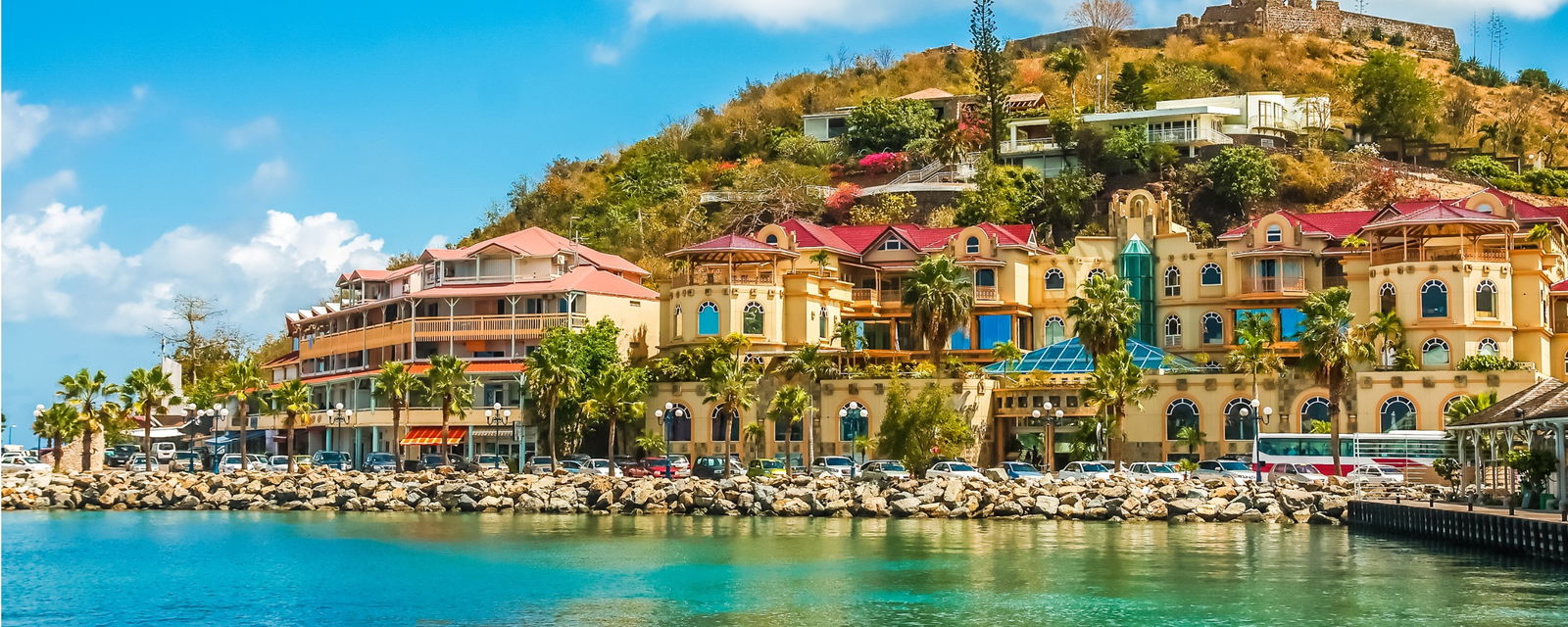


This quintessential Caribbean town is full of colorful houses and architecture, duty-free shops, and, of course, everyone’s favorite watersports activities. Marigot, once a small fishing village, is named for the swamps upon which it was built and is the capital of the French side of Saint Martin. The rise of sugar cane production in the 18th century helped this town grow into what it is today. Marigot is known for its rich history as can be seen at the historic Fort Louis, the Catholic Church of St. Martin’s, and the former Spring Sugar Mill. Enjoy the warm, tropical weather on the water snorkeling, diving, or enjoying a boat charter. Also known for its natural beauty and stunning flora and fauna, visitors will appreciate the beauty of the 424-meter summit of Pic Paradis or the National Nature Reserve of Saint Martin. In fact, the mountains to the next to Marigot keep it from being as rainy as other Caribbean islands, so it’s the perfect vacation destination. Be sure to bring some extra cash so you can explore the markets at your heart’s content.
Known for its duty-free shopping, Marigot is booming with luxury boutiques and French fashion. Visitors will find the world’s most famous designers at prices that can’t be found anywhere else just by wandering down the picturesque streets of town. Another must-see is the locally-run, open-air Marigot Market that’s best known for its local food and culture. Experience intoxicating smells and colors while shopping for fresh fruit and vegetables, spices, local rum, local artwork, and more.
Built in 1789 as a defensive fort to protect the harbor warehouses, Fort Louis has been an important part of the town’s safety and offers an insight into the history of the area. The site is undergoing the third renovation of its history thanks to the Hope Estate Archeological Association. Visitors enjoy the must-see views of the surrounding beaches and bays from the top of the fort. At the base of the fort, you can follow an alleyway that leads to the island’s first prison. The building holds its same original appearance, but was converted into a fire station in 1968.
One of the main thoroughfares in the city, the Rue de la Republique, is best known for showcasing the island’s colorful, 19th-century architecture. After years of exposure and use, these homes have kept their architectural authenticity quite well. Visitors and locals come here to wander the streets and lose themselves in the sights of the gingerbread friezes and the thoughtfully and brightly decorated balustrades. This popular street leads visitors right to the waterfront where the Marigot Market sits.

Marigot's winter, from December to February, offers warm and pleasant weather with temperatures ranging from the mid-70s to low 80s Fahrenheit. It's an ideal time to visit the capital city of the French side of Saint Martin as it allows for enjoyable exploration of its charming streets and coastal attractions. Winter is perfect for strolling through the Marina Port La Royale, where visitors can find boutiques, restaurants, and cafes overlooking the picturesque marina.

Spring in Marigot, from March to May, brings slightly warmer temperatures with highs in the low to mid-80s Fahrenheit. The city's landscapes remain green and lush from the previous rainy season. Spring is ideal for relaxing on the sandy beaches of Baie Rouge and Baie Nettle, known for their serene ambiance and turquoise waters. Visitors can also explore nearby nature reserves like the Reserve Naturelle de la Baie de l'Embouchure for birdwatching and hiking.

Marigot's summer, from June to August, marks the beginning of the rainy season. While it can be hot and humid with temperatures in the mid-80s to low 90s Fahrenheit, it also provides a refreshing atmosphere amid the lush surroundings. Summer offers opportunities for experiencing local culture and attending events like the Saint Martin Carnival, a lively celebration with colorful parades and traditional music. Visitors can also take boat tours to explore nearby islets and enjoy snorkeling and diving in the clear waters.

Fall in Marigot, from September to November, is the peak of the rainy season. The weather remains warm and humid, with temperatures ranging from the mid-70s to low 80s Fahrenheit. Despite the rains, fall is an excellent time to experience the city's vibrant atmosphere and take advantage of lower tourist crowds. Visitors can explore the Fort Louis, an 18th-century fortress offering panoramic views of the city and the sea. Fall is also an ideal time to taste delicious French and Creole cuisine at the town's restaurants and enjoy the laid-back ambiance of the French Caribbean.